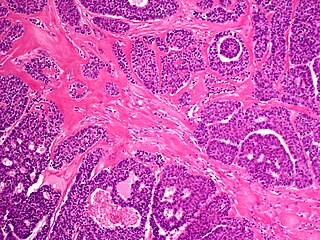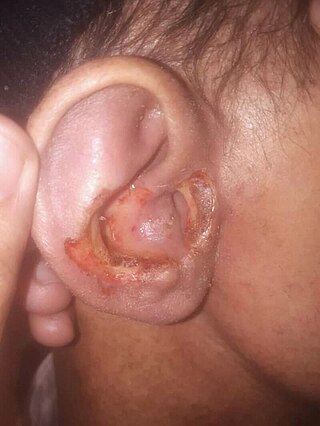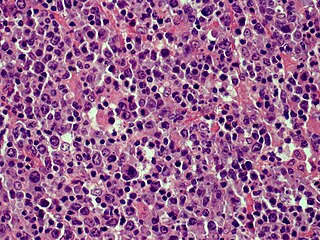Related Research Articles
Unilateral nevoid telangiectasia presents with fine thread veins, typically over a segment of skin supplied by a particular nerve on one side of the body. It most frequently involves the trigeminal, C3 and C4, or nearby areas. The condition was named in 1970 by Victor Selmanowitz.

Nevus lipomatosus superficialis is characterized by soft, yellowish papules or cerebriform plaques, usually of the buttock or thigh, less often of the ear or scalp, with a wrinkled rather than warty surface. It is usually congenital in origin or appears within the first three decades.

Angioma serpiginosum is characterized by minute, copper-colored to bright red angiomatous puncta that have a tendency to become papular.
Glomeruloid hemangioma is a distinctive vascular tumor first described in 1990 when found to be associated with POEMS syndrome and Castleman disease. Glomeruloid hemangiomas can manifest as wine-red sessile or pedunculated papules, papulonodules, subcutaneous bluish compressible tumors, or small, firm, reddish-violaceous, dome-shaped papules.

Solitary mastocytoma, also known as cutaneous mastocytoma, may be present at birth or may develop during the first weeks of life, originating as a brown macule that urticates on stroking. Solitary mastocytoma is a round, erythematous, indurated lesion measuring 1-5 cm in diameter. It can be mildly itchy or asymptomatic and develops over time. Predilection is the head and neck, followed by the trunk, extremities, and flexural areas.
Cutaneous meningioma, also known as heterotopic meningeal tissue, and rudimentary meningocele is a developmental defect, and results from the presence of meningocytes outside the calvarium.
Onychoatrophy, also known as nail atrophy, is a faulty underdevelopment of the nail that may be congenital or acquired, in which the nail is thinned and smaller.
Median nail dystrophy, also known as dystrophia unguis mediana canaliformis, median canaliform dystrophy of Heller, and solenonychia consists of longitudinal splitting or canal formation in the midline of the nail, a split which often resembles a fir tree, occurring at the cuticle and proceeding outward as the nail grows.
Erythromelanosis follicularis faciei et colli is an erythematous pigmentary disease involving the follicles, characterized by a reddish-brown, sharply demarcated, symmetrical discoloration involving the preauricular and maxillary regions.

Dermatitis artefacta, also known as Factitious dermatitis, is a form of factitious disorder in which patients will intentionally feign symptoms and produce signs of disease in an attempt to assume the patient role. It is also self-inflicted skin damage, most commonly from prolonged deliberate scratching, but sometimes by means of sharp instruments or another agency.

Generalized bullous fixed drug eruption (GBFDE) most commonly refers to a drug reaction in the erythema multiforme group. These are uncommon reactions to medications, with an incidence of 0.4 to 1.2 per million person-years for toxic epidermal necrolysis and 1.2 to 6.0 per million person-years for Stevens–Johnson syndrome. The primary skin lesions are large erythemas, most often irregularly distributed and of a characteristic purplish-livid color, at times with flaccid blisters.

Malignant acrospiroma, also known as nodular hidradenocarcinoma, malignant nodular clear-cell hidradenoma, mucoepidermoid hidradenocarcinoma, clear-cell hidradenocarcinoma, malignant clear-cell acrospiroma, and clear-cell eccrine carcinoma, is a rare and aggressive tumour of the eccrine sweat glands. It was first documented by Keasbey and Hadley in 1954.
Pigmented hairy epidermal nevus syndrome, also known as Becker's naevus syndrome, is a cutaneous condition characterized by a Becker nevus, ipsilateral hypoplasia of the breast, and skeletal defects such as scoliosis.

Trigeminal trophic syndrome is a rare disease caused by the interruption of peripheral or central sensory pathways of the trigeminal nerve. A slowly enlarging, uninflamed ulcer can occur in the area that has had trigeminal nerve damage; including but not limited to the cheek beside the ala nasi.
Annular elastolytic giant-cell granuloma is a cutaneous condition characterized histologically by a dermal infiltrate of macrophages.
Progressive nodular histiocytosis is a cutaneous condition clinically characterized by the development of two types of skin lesions: superficial papules and deeper larger subcutaneous nodules. Progressive nodular histiocytosis was first reported in 1978 by Taunton et al. It is a subclass of non-Langerhans cell histiocytosis and a subgroup of xanthogranuloma.

Cutaneous B-cell lymphomas (CBCL) constitute a group of diseases that occur less commonly than cutaneous T-cell lymphoma, and are characterized histologically by B-cells that appear similar to those normally found in germinal centers of lymph nodes. Conditions included in this group are:
Pseudoepitheliomatous keratotic and micaceous balanitis, (PKMB) is a cutaneous condition characterized by skin lesions on the glans penis that are wart-like with scaling. It can present as a cutaneous horn. PKMB is usually asymptomatic, with occasional irritation, burning sensation, fissuring, or maceration.

Cylindroma is a rare, slow-growing, benign tumour of the skin. It mostly affects the face, scalp, and neck regions.
Porokeratotic eccrine ostial and dermal duct nevus (PEODDN) is a skin lesion that resembles a comedonal nevus, but it occurs on the palms and soles where pilosebaceous follicles are normally absent. It is probably transmitted by paradominant transmission.
References
- ↑ Rapini, Ronald P.; Bolognia, Jean L.; Jorizzo, Joseph L. (2007). Dermatology: 2-Volume Set. St. Louis: Mosby. p. 1899. ISBN 978-1-4160-2999-1.